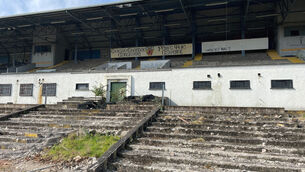Paul Rouse: Any serious footballer must be excited about this year's calendar

Down players warm-up before the Dr McKenna Cup semi-final against Derry at Pairc Esler last week. Picture: Ben McShane/Sportsfile
This is a football season like no other.
The pre-season competitions have already seen counties play around three competitive matches each. There have also been sundry challenge matches around the country.
But now we are into the real stuff.
Between January 28th and March 26th, the National Football League will see intercounty teams playing seven matches in nine weekends.
The league finals will then be played on the following weekend, April 1st and 2nd.
The weekend after that – April 8th and 9th – the provincial championships will start and will run week after week.
Moving into the May, the Connacht and Ulster Football Finals would be held on May 6th and 7th, followed by the Leinster and Munster deciders a week later.
The qualifiers for the Sam Maguire and Tailteann Cup competitions take place over three weekends, starting on May 20th, with counties playing off in groups of four.
There are then preliminary quarter-finals, quarter-finals, semi-finals and finals.
This means that if a team has a middling provincial championship (not even making a final), and reaches the quarter-final of the Tailteann Cup or the Sam Maguire, they will play some 15 matches in 21 weeks.
That is a serious undertaking. There will be injuries and fatigue and general wear-and-tear.
But it is also something that no serious footballer should be anything other than excited about. Basically, playing these matches has to beat the relentless grind of training.
One of the most frustrating things in sport must be to be outside the matchday squad but in the wider panel of a senior inter-county team. To train like a fulltime athlete, but not to get a game is brutal.
With this year’s championship, though, a strong panel is obviously going to be seriously useful. The door will be opened to more players than previously was the case. And if you don’t get a look in this year, you can consider yourself in no doubt as to where you are rated by a team management.
Of course, players will be hoping that 15 matches in 21 weeks will actually be more than that. First there are the semi-finals. And then the second-ever Tailteann Cup final is down for July 15th or 16th, and the All-Ireland Football Final takes place on Sunday July 30th, a week later than last year.
The ambition to be still playing in July is a legitimate one for many footballers who will tog out for their counties in the first round of the league. There is something genuinely wrong if that is not their ambition.
What is clear, also, is that there can be few complaints now about the training-to-matches ratio.
Nobody with a passing knowledge of Gaelic football will lament the passage of the old system where the National Football League was played off by early April at the latest. This was followed by the attempt to crowbar a round of club championships in April. (Or maybe two, leaving clubs in some counties basically finished for the year.) Then, the provincial championship would start in early May and proceed at a leisurely pace through the summer and into the autumn. Teams routinely were given three weeks or longer between matches.
Those players who laboured for decades and played maybe eight matches in the middle of ten months of training are surely jealous of the opportunities that await the 2023 cohort.
It was the kind of madness that is almost impossible to believe. But the basic structure and its crazy calendar lasted for the guts of 130 years. Maybe it was just growing pains.
It was perplexing last year to year people calling for the split season to be abandoned halfway through its first offering.
It may become apparent that, over the coming years, the ratio of matches to training has been rebalanced too far in the opposite direction.
Indeed, it is apparent that there will definitely be tweaks needed to the calendar and to the structure of the championship in the coming years. The farce that was this year’s O’Byrne Cup shows that things are not yet running smoothly. But there is nothing there that cannot be fixed.
Similarly, the overlap with Sigerson Cup and redesign and timing of the All-Ireland Under-20 championship is far from ideal. But a small dose of common sense in the management of players should smooth most potential problems.
As always, of course, there will be shadow-boxing by the top contenders for the Sam Maguire. It will be fascinating to watch how Kerry go about the League. The legacy of the club commitments of David and Paudie Clifford, the retirement of David Moran, and the catalogue of injuries means Kerry will struggle to go on the kind of extended winning streak that was the hallmark of Dublin’s successful years.
They will want to win, of course, but Kerry’s League will surely be about experimentation to try and find a new midfielder (or two), a new wing forward and a few more defenders?
The introduction of group stages into the All-Ireland championship most likely puts a premium on deepening the squad.
Again, though, the most compelling thing in Division 1 will not be who wins the competition, but the contest to avoid relegation.
Through the rest of the divisions, the battles for promotion and relegation ordinarily define each counties season. For example, if you cannot get promoted from Division 2, it is hard to see how you can win the Sam Maguire.
The fact that Dublin are in Division 2 adds another aspect. To begin to re-establish themselves as the leading team in the country, they will need to go undefeated through the Division and use that as a springboard.
But there are pretenders to ultimate success there, too, in Kildare and Derry. If neither wins promotion, it will surely be a case of momentum stalled.
Most interesting of all will be the case of Cork. Is there an awakening underway?
Divisions 3 and 4 can lay claim to be the most interesting. There is no sense here that any team can spend its time experimenting or building a panel. This is raw and brutally competitive from the first week.
There is a notion that the structure of the league is a success because it creates capacity for teams to progress in increments. Do things correctly and you can build a future, is the claim.
There is only the most limited evidence that this is true.
For example, 13 of the 16 teams who played in Division 1 and 2 when the current league format was divised in 2008 are still there.
And of the nine teams who played in Division 4 of the league in 2008, only Clare are now in the top two divisions.
Some counties – Laois, Tipperary and Cavan, for example – have gone up only to fall again. And Laois are down in Division 4 now, having spent the years between 2008 and 2016 moving between Divisions 1 and 2.
This weekend, the hope for every team will be that they spend the next nine weeks looking up; the alternative is a long hard spring of loss.







